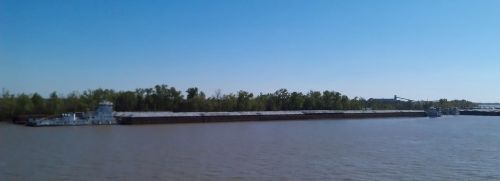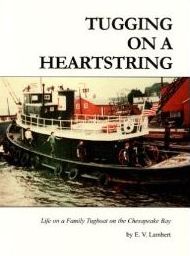Tugboat mariners are an independent sort and we’re accustomed to enjoying a measure of autonomy that few industries allow. We don’t take kindly to the “clueless” telling us anything, much less how to do our job. We’re used to the press not having a clue, we’re used to answering the same old questions over and again about what it’s like on a tug. We’re thankful that when we’re underway the world shrinks to the tug, tow, and our immediate horizon.
When we watch those poor bastards driving (more like crawling) on the B.Q.E. and F.D.R. Drive as we sail by, we thank our lucky stars we’re not faced with that every day. But unlike them, we have an “alphabet soup” of Federal and State agencies looking over our shoulder. Insurers, customers, and employers alike pile on to make our jobs just a little more interesting.
The trip that takes our daily commuter from his front door to his place of employment is seldom given more thought than to decide what size coffee to pick up with his bagel or scone every morning. It doesn’t require too much preparation, just a full tank of gas, a friendly traffic report, and perhaps set his “Tom Tom” for an alternate route .
Up until about 15 years ago, like our commuter, voyage planning in the N.Y. towing sector was still an informal exercise. The plan was always fluid with the distinction of being mostly in our heads as opposed to written down. Planning seldom got too complex, we didn’t see a need to write down what we could recite from memory. The term “voyage plan” wasn’t in the vernacular.
To us, it wasn’t broken. So of course it had to be fixed.
In the mid-90’s I was attending the first Bridge Resource Management course offered for tug masters by the Seaman’s Church Institute in New York City. There were eight seasoned tug captains in our group and one or two qualified as “Tugasaurs”, meaning they had been in “tow-biz” since Christ was an “Ordinary”. We were on the company dime and didn’t really know what to expect from a class that was undoubtedly more suited to a ship than a tug.
Except for playing with the newest simulator, the curriculum promised to be about as exciting as a root canal when our instructor, a young ship driver/academy man, introduced himself and began reviewing the need for the practices he was going to impart. The more he talked, the uglier it got. It proceeded to get bloody (figuratively) as we began to chew this guy down to his ankles. I mean, who the Hell did he think he was telling N.Y. boatmen how to do their job? He’s never set foot on a tug much less handled one.
It wasn’t long before our “victim” saw the cavalry arrive in the person of Captain Rich Weiner (pronounced “wine-r)”. This poor bastard’s savior was just in time to prevent his bloodied carcass from being dragged to the seawall and summarily dispatched as eel-bait.
Captain Weiner is a well respected and widely known docking master in New York Harbor and has worked with many of us over the years. Once Rich walked into the room, the pack eased off long enough to hear the same message delivered. And although he delivered the very same message, he had status as one of us. His reputation and expertise gave him the credibility to make clear that the issue was the message, not our unfortunate messenger.
After the grumbling settled down, Captain Weiner was able to smooth our ruffled feathers and explain how voyage planning was being required and formulated. Whether we liked it or not he explained, we should be the ones deciding how it should be done. Having others decide how we do our jobs was even more distasteful than the new idea itself. So, in the end we all drank the Kool-Aid.
It was difficult to admit that it was a good idea at first, especially since our voyage planning seemed perfectly adequate to us. The more Captain Weiner talked, the more it became clear that our customary practices were not enough to satisfy the “powers-that-be” and were necessarily being replaced by the increased paperwork and tedium.
It simply became impossible to argue against the need for detailed passage and voyage planning. The fact that it must be written down was probably the most irritating part of the idea since our paperwork load was increasing exponentially every day.
With that said, it was obvious that knowing where, when and how are key to a safe and hopefully uneventful passage from point “A” to point “B”. There’s little difference between a tug or a ship’s voyage planning when it comes to the considerations of wind, weather, available depth, current, and way-points. Arrival times at key points along the route, DR positions, current set and drift are always critical considerations now more than ever in the age of OPA90., the Clean Water Act, and any number of State Regulations.
These days the practice is deeply ingrained in our procedures and codified by customers, company policy, insurance providers, and ISM safety management systems. Everyone uses a different template, but they share the same basic information. These plans allow us to visualize the entire transit and determine ETA’s with greater accuracy. The plan is an overview of our vessel’s presence of mind along the way. At any point in the trip we can have a clear and detailed reference of how things are going. Guesswork is reduced to a minimum.
On top of that, it is a professional approach, proof that the vessel, crew and cargo is in “good hands”.
We aren’t being asked to be clairvoyant or perfect, the document is a “working” plan subject to updating as we go. There’s little doubt it’s for the better, “Tugasaurs” notwithstanding.
If you aren’t conducting and detailing a policy of voyage/passage planning, you will be. ISM Safety Management Systems are built around international law and customary practice, within which voyage planning has become an integral practice. Sooner, rather than later, you’ll be asked to do this. Better to do it now so you control how it’s formatted instead of having some geek do it for you.
Passage plans and voyage plans are synonymous, the voyage starts long before we sail with the collection of the vessel/tow

particulars including:
Deep draft, of the tug and tow
Cargo, grade and amount
Vertical and under-keel clearances, including “vessel squat“
Expected speed over the route and waypoints (courses and distances),
Tidal heights and current (set and drift) for critical points along the track-line, including departure and arrival
Estimated time en route
Estimated arrival times, at waypoints and final destination
Berth information, chart catalog, pubs last update
Pilots and escort/assist boats, required or not
Once this information has been collected and detailed on the plan, we can refer to and update the all important ETA as we go along. Adjustments, observations and delays are all considered. The greatest benefit is that our situational awareness is enhanced by the plan. We have considered and calculated a D.R. for the entire trip giving us a good basis for setting up assists, line handlers, pilots and crew changes.
A well prepared passage plan is akin to the FAA’s required flight plan. How long will it be before tugs with tows have to file our own “flight plan” with a government agency sometime in the future? I’ve read discussions pointing to that possibility, I would hope if that should come to pass it will be under the control of licensed and experienced mariners with the local knowledge for each area of concern.
Of course it’ll be up to us to take an active part in the process before the clueless run us into each other or aground. As distasteful as change may be, it’s better if those of us on the job have a say in how it should be done. I’d recommend that the “powers that be” continue to embrace the idea of deferring to expertise, it just makes sense.
Read Full Post »








































